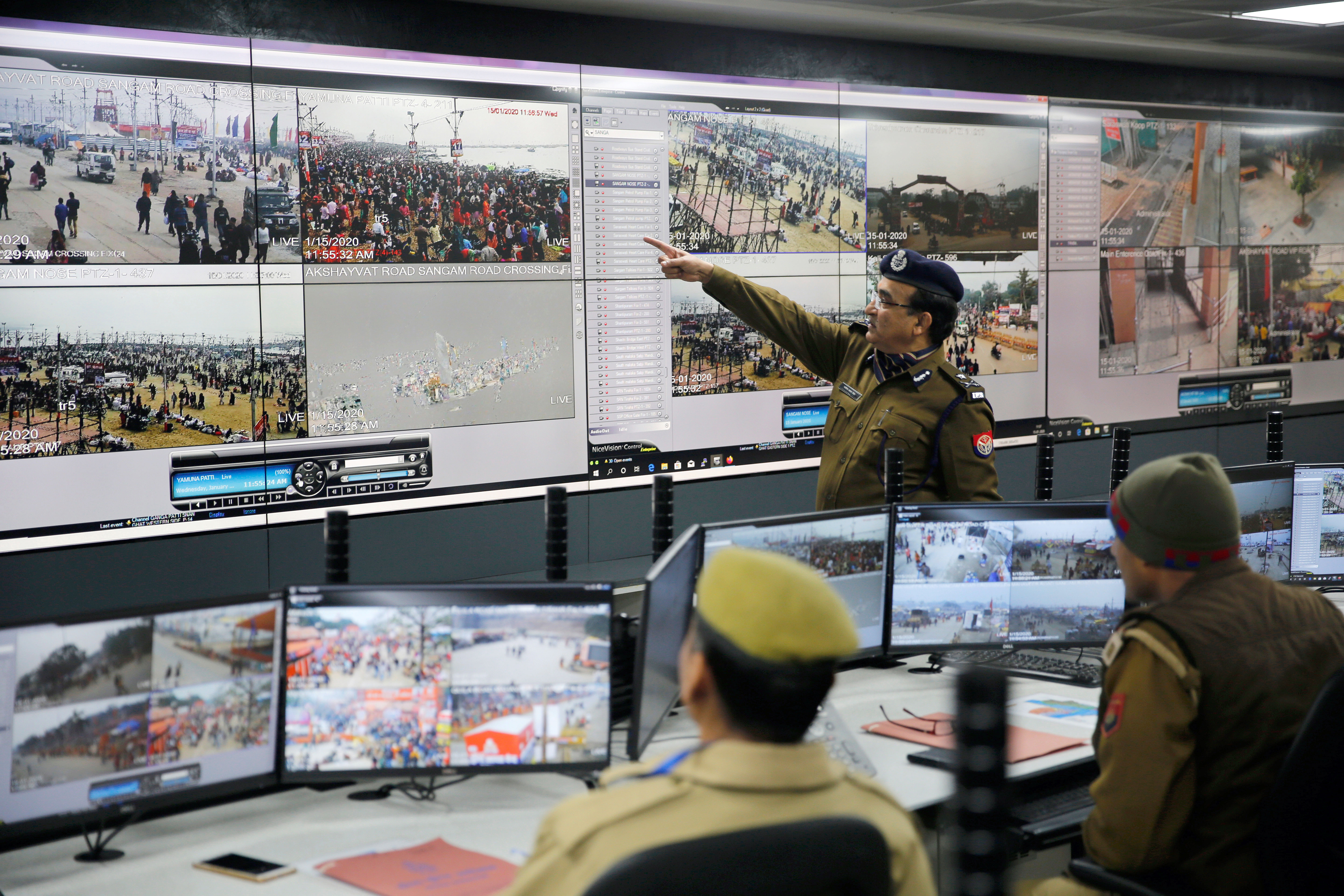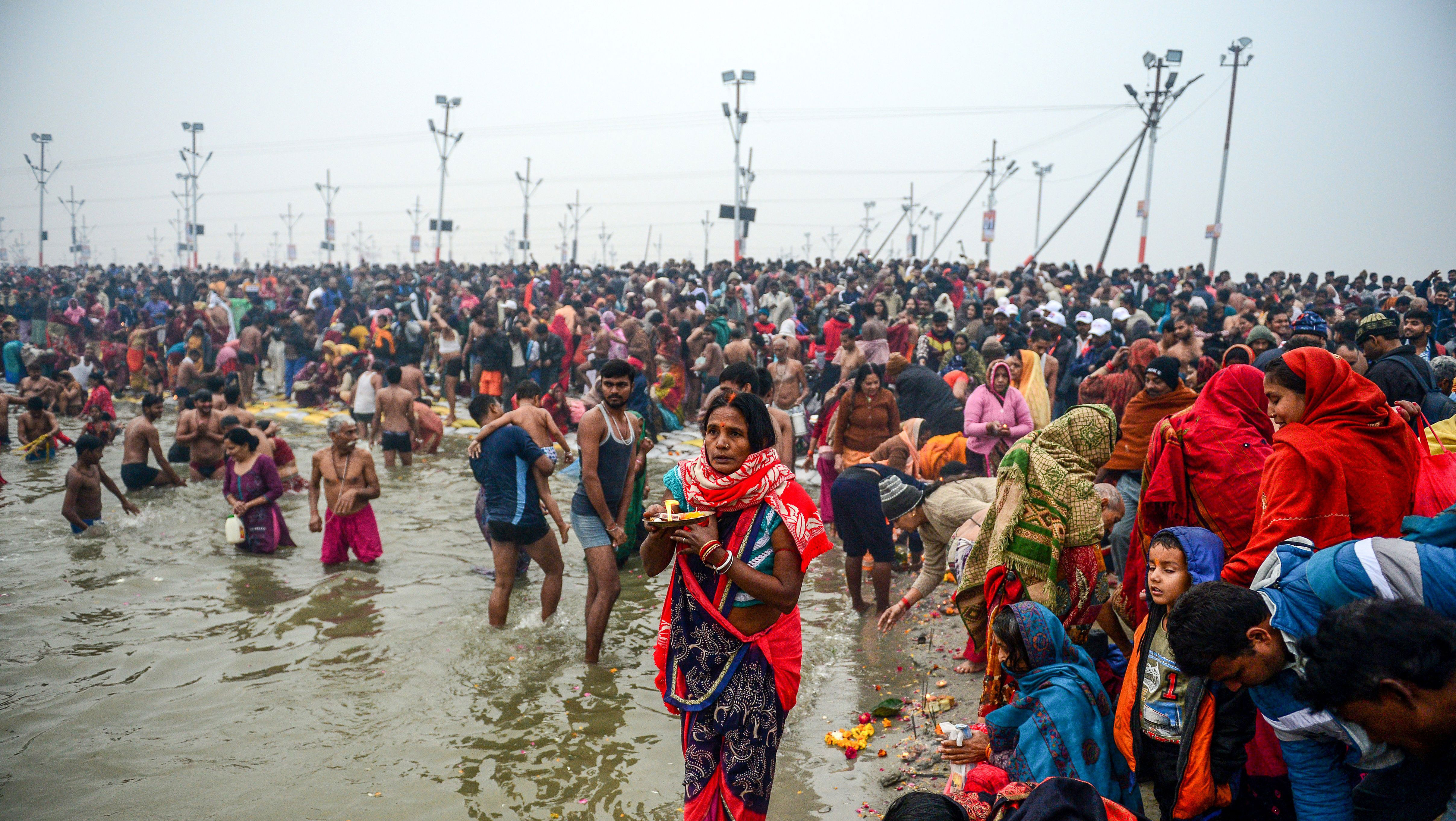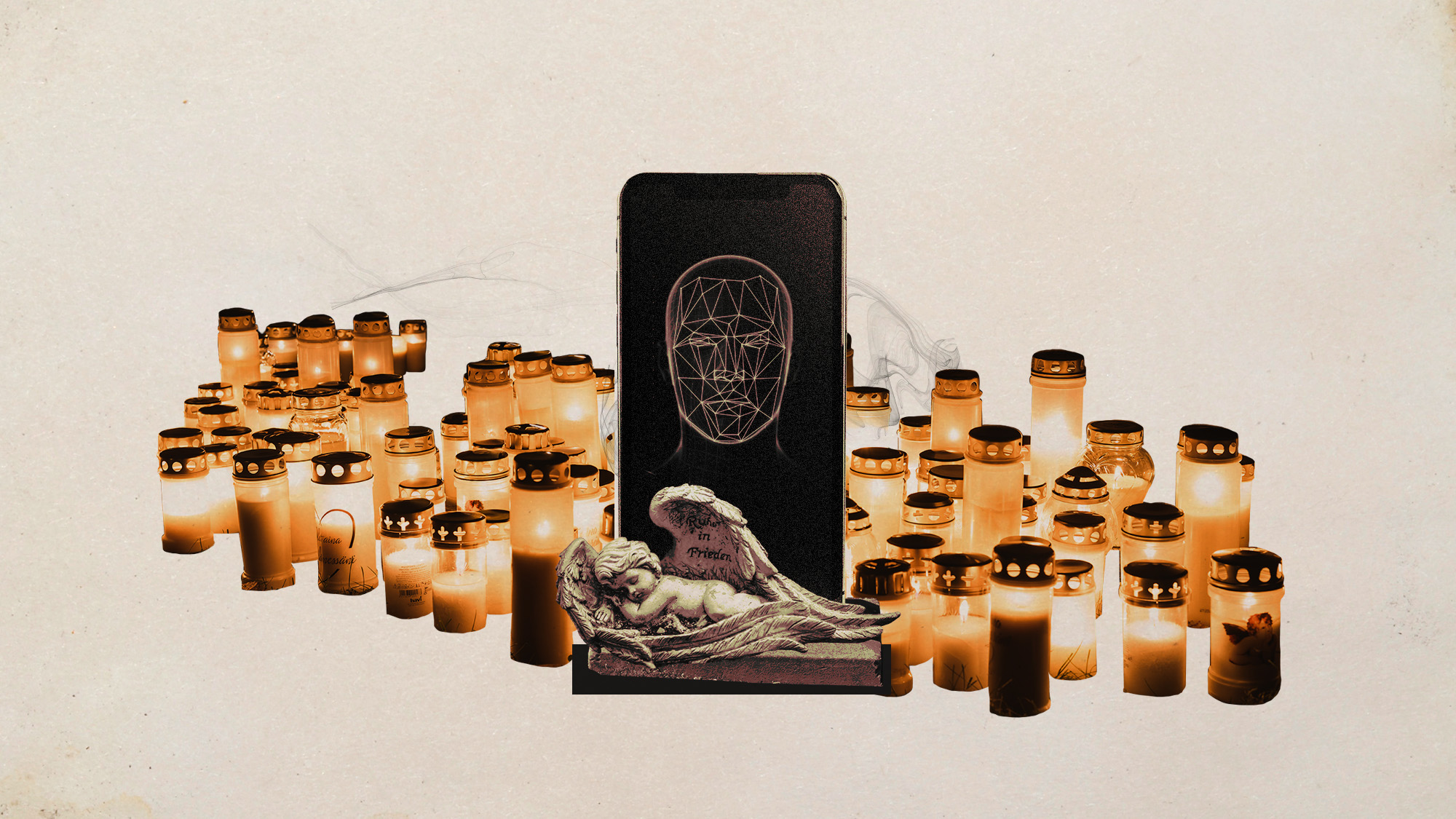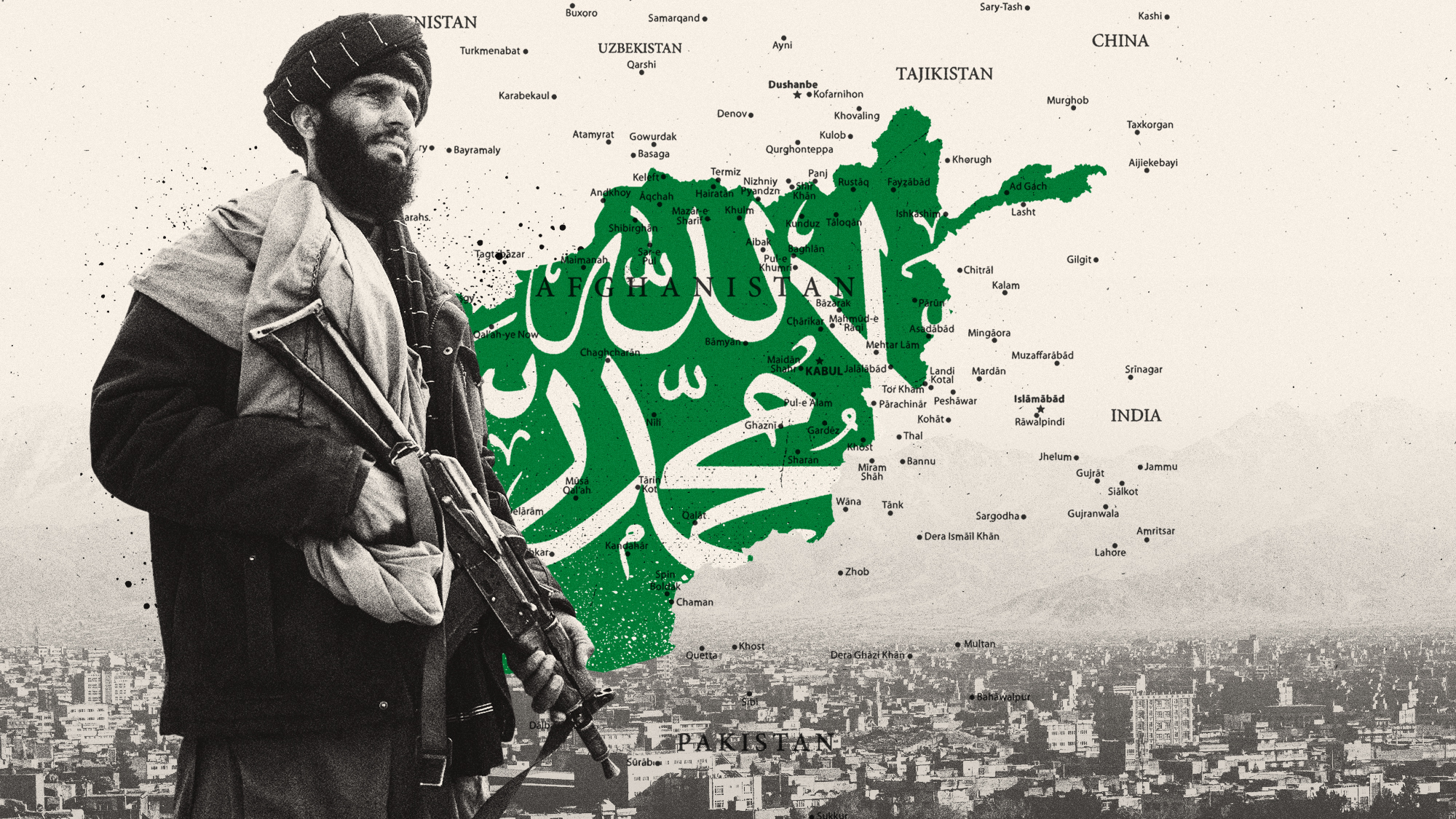Magh Mela: watching over the world’s biggest festival
Keeping tabs on millions of pilgrims has led to the building of a surveillance mini-state, says Monica Jha

It’s 3.13am, and Radio Inspector Ashok Kumar turns to look at his computer. His face stiffens. He zooms in on the screen and squints at an unauthorised SUV crossing a pontoon bridge. Kumar and his team are in the Integrated Command and Control Centre (ICCC) overlooking operations for this year’s Magh Mela, an annual Hindu pilgrimage and festival attended by millions of people. Each year, devotees from across the country congregate at the spot where the Ganges, Yamuna and mythical Saraswati rivers converge at Prayagraj (formerly Allahabad) in the northern Indian state of Uttar Pradesh. There, devotees dip in the water, which they believe cleanses them of sins.
It is here at the ICCC, a large white room with two rows of desks, that the police keep watch over the mela (Sanskrit for “a fair”). Officers hunch over computers as they monitor feeds from 700 CCTV cameras. A video wall dominates, with 55-inch screens arranged in a 10x2 matrix. Khaki jackets emblazoned with “Uttar Pradesh Police” hang on the backs of the chairs. Tapping shoeless feet on the carpeted floor, the officers glance at each other regularly. A tentative nod implies that everything is fine.
The monitoring team is on high alert. Kumar and his colleagues have been here since 8pm last night, on a 12-hour shift, and the first bathing rituals began at 3am. Today is 9 February, the full moon day of Maghi Purnima. Police are expecting a crowd of 7.5 million - down from a single-day peak of 11 million two weeks earlier. Millions of pilgrims will be leaving after today’s dip. Many are joined by their families, who have come to take them home. Kumar’s job is to keep this massive crowd under control. Stampedes, terror attacks and theft are on his mind. He places a call, and minutes after the SUV is vetted, a police officer appears on-screen to set up a barricade at the foot of the bridge. Outside, the sunrise turns the sky crimson. On the water, boats stand out in silhouette. The air is suffused with a mix of piety and festivity.
The Week
Escape your echo chamber. Get the facts behind the news, plus analysis from multiple perspectives.

Sign up for The Week's Free Newsletters
From our morning news briefing to a weekly Good News Newsletter, get the best of The Week delivered directly to your inbox.
From our morning news briefing to a weekly Good News Newsletter, get the best of The Week delivered directly to your inbox.
The Magh Mela is a smaller version of the Kumbh Mela, the largest human gathering on Earth. The Kumbh is held every six years - most recently in 2019. Over 49 days last year, more than 250 million people took a dip in the Triveni Sangam (the “triple confluence”, or point where the rivers meet). On one day, the crowd reached 50 million - the second-largest gathering in history.
To prepare for the melas, tens of thousands of officials spend months setting up a massive temporary city on the banks of the Ganges. Viewed from above, it is a colourful patchwork divided by large and small bodies of water. Much of this - tents, floating bridges and metal sheet roads - is built specifically for the festival. As the riverbed floods every year, the city lasts only a few months before the Ganges threatens to reclaim the land.
The physical structure of the mela changes each year, depending on the river. The groundwork usually starts in October, after the monsoon season. Temporary roads are marked; pontoon bridges are built; pipelines and electricity cables are laid; and bathing stations are set up along a three-mile floating jetty.
This year, water levels in the Ganges remained high later than usual - while “heavy rains kept hampering works until December”, says Rajneesh Mishra, a civil servant who oversees the mela. This year’s event was spread over 667 acres (270 hectares), almost twice the size of London’s Hyde Park, and divided into six sectors for administrative purposes. Setting up the infrastructure was - and is - an immense logistical feat. The mela has 13 police stations and five hospitals with operating theatres, labs, testing facilities and 25 beds each. All of this comes at a price. This year, the state budgeted $77m. Last year, for the Kumbh, it spent $558m.
A free daily email with the biggest news stories of the day – and the best features from TheWeek.com
The festival’s IT operations are run by the ICCC, which is based in a three-storey building - one of the site’s few permanent structures, along with a temple and a 16th-century fort. The centre itself is divided between the monitoring room, which uses a video surveillance system to keep a bird’s-eye view on the mela; the wireless grid room, which liaises between monitors and ground staff; the war room, where personnel from the fire, water and police departments as well as the military are on hand to deal with emergencies; and, finally, a call centre. At the heart of these operations is the ICCC’s crowd management application system, which keeps an eye on crowd density across all 700 camera feeds and can estimate the number of people in any space with 85% accuracy. If there are more than three people per square metre, it issues a warning, and the ground police team is alerted.
It’s now 7.17am. Mamta Sharma stands knee-deep in the river. Facing east toward the Ganges, she presses her hands in a namaste greeting. She bows her head and chants a prayer under her breath, before taking a dip in the water. Some devotees hire boats to get to the exact location of the sangam, where it’s said you can see the whitish Ganges water mix with the black of the Yamuna. Most pilgrims can’t afford a boat, however - so like Sharma, they bathe close to the bank instead.

When she comes out of the river, Sharma – who is 31 and lives in the eastern city of Kolkata – video-calls her mother, who was not able to come with her. She pans her phone to show her the sangam, and her mother’s eyes well up. As she dries off, Sharma looks up expectantly. On some auspicious days, the mela administration showers flowers on bathing devotees from a helicopter. She has seen videos of it on social media. “We were all excited about it, but it hasn’t happened today,” she says. “Still, the holy dip is quite an experience.”
Ajay Nishad, a boatman who has been ferrying visitors to the sangam for three years, says the melas are always well organised. But lately, he tells me, he has noticed something new. Officials have started using a lot of cameras. “Just look up,” he explains, pointing to a drone over the river. “It’s watching everything.”
It was at last year’s Kumbh Mela that the ICCC proved its worth. On Mauni Amavasya - the day that drew the crowd of 50 million - officials defused a situation that threatened to turn dangerous. Around 5pm, as the auspicious hour for the holy bath ended, millions of people left the mela and rushed towards the local railway station. Within minutes, it was overflowing. Vipin Singh, the assistant manager of the Prayagraj Smart City Mission team, which oversees the ICCC, recalls that people weren’t able to move an inch. “It was a very tense situation,” he says.
Hanging over that moment was the memory of the 2013 Kumbh, when a stampede led to the deaths of 37 people at the station. The exact sequence of events remains contentious, but an inquiry found that North Central Railways authorities had underestimated the crowd size and failed to arrange enough trains, while the state government failed to deploy nearly 6,000 buses to relieve pressure. Police also bungled crowd management. This wasn’t the first time such a tragedy had occurred: since 1820, there have been more than half a dozen stampedes at Kumbh celebrations. In 1954, 500 people died when panic broke out.
This time, however, smart cameras had already flagged areas where human density had reached unsafe levels and alerted officials about an impending stampede. It was the first time an AI-based crowd-management system had been used in India. At ICCC HQ, the authorities issued instructions to cordon off a junction on the way to the station: police formed a human chain around a 15,000-strong crowd. An additional 30,000 people were diverted to a nearby garden to keep them away from the roads. To clear out the station, the ICCC used cameras to estimate the number of extra trains needed. By the end of the day, 75 more trains had been added, and a major disaster had been averted.
Around 9pm on 4 February, a policeman in the monitoring room was watching the video feeds from the tent city. It had been an uneventful day until then. “What is it?” he said, to nobody in particular. He was already zooming in on a screen. Images of rising smoke came up. “It’s a fire,” he shouted. Immediately, he picked up the phone and called the wireless grid. “A fire in a tent! It has just started.” The smoke rose from a camp where thousands of devotees had pitched their tents next to each other. The ground response team was informed. Moments later, firefighters reached the spot and put out the fire. All of this took less than a minute, without pilgrims even noticing what was going on. “People in the tents were surprised to see them,” says fireman S.S. Dubey.
Because so many people pitch tents at melas and cook their own meals, gas fires are fairly common. At least four fires have broken out this year alone, says Ashutosh Mishra, the mela’s Additional Superintendent of Police. Previously, officials had to rely on tips from the public to learn about these blazes, he tells me. But in 2020, video technology has reduced response times to “less than two minutes”.
This year, the police have also introduced a computerised missing-persons centre to match individuals with descriptions of lost people. There’s perhaps an irony in the fact that a multimillion-dollar tech apparatus governs the experience of millions of devotees whose relationship with technology is peripheral at best. As they try to release themselves from the cycle of rebirths and attain salvation, it is unlikely this is at the front of many pilgrims’ minds.
Back at the ICCC on 9 February, assistant manager Singh checks video feeds from the station. He seems pleased with how the day has gone. While last year’s Kumbh Mela was instructive for his team, the much smaller Magh Mela has allowed them to refine techniques. “We’re using this mela to gather more data for deep learning,” he says. As an example, he offers the problem of waste removal. To keep the site clean, AI-enabled cameras have been set up and trained to send a signal to a nearby bin lorry when a rubbish bin is full. Singh’s team is even developing a system designed to automatic-ally photograph people who drop litter.
The systems in place at the mela demonstrate the growing role of surveillance in India. In a landmark 2017 ruling on Aadhaar (the national biometric identity-card programme), the country’s Supreme Court declared individual privacy to be a fundamental right. This, however, has not stopped Narendra Modi’s government from expanding the use of surveillance technologies such as facial recognition in daily life. Last December, police used software to track people at a New Delhi rally; the government also intro-duced the Personal Data Protection bill, empowering them to collect anonymised personal data. N.S. Nappinai, a cyber-law specialist, says that there are no specific regulations or precedents currently governing such technology. She warns mela attendees that “a substantial portion of personal data is being collected” via facial recognition technology, and will be retained afterwards.
Back at the mela, the day has wound down, and Mamta Sharma is pleased with her experience. “Nowhere were we pushed around or rushed,” she says. “It is crowded, but we can keep walking. I don’t know how they organised it, but they did it very well.”
This year’s mela will last for a further 12 days or so, with another big gathering at the end. But for now, devotees who came just for the day are leaving. Pilgrims are vacating camps, tying their belongings into neat little bundles, and loading them on vehicles. Some are rushing to fill up a last container with holy water. On the banks of the river, women squat as they offer their evening prayers. Young girls light earthen lamps and place them in the water. A couple married the previous night are still in their wedding attire. They bow to the sangam for blessings. Around them, boatmen pose for pictures. An old man, clad in saffron, picks up a crutch and stands to offer his respects to the river. Before him, the golden waters of the sangam blend into the grey mist. The sun has set over the mela.
A longer version of this article appeared on restofworld.org
© Rest of World 2020
-
 What new cryptocurrency regulations mean for investors
What new cryptocurrency regulations mean for investorsThe Explainer The Treasury and the Financial Conduct Authority aim to make the UK a more attractive and safer place for crypto assets
-
 The Salt Path Scandal: an ‘excellent’ documentary
The Salt Path Scandal: an ‘excellent’ documentaryThe Week Recommends Sky film dives back into the literary controversy and reveals a ‘wealth of new details’
-
 AI griefbots create a computerized afterlife
AI griefbots create a computerized afterlifeUnder the Radar Some say the machines help people mourn; others are skeptical
-
 How Bulgaria’s government fell amid mass protests
How Bulgaria’s government fell amid mass protestsThe Explainer The country’s prime minister resigned as part of the fallout
-
 Normalising relations with the Taliban in Afghanistan
Normalising relations with the Taliban in AfghanistanThe Explainer The regime is coming in from the diplomatic cold, as countries lose hope of armed opposition and seek cooperation on counterterrorism, counter-narcotics and deportation of immigrants
-
 Pakistan: Trump’s ‘favourite field marshal’ takes charge
Pakistan: Trump’s ‘favourite field marshal’ takes chargeIn the Spotlight Asim Munir’s control over all three branches of Pakistan’s military gives him ‘sweeping powers’ – and almost unlimited freedom to use them
-
 Femicide: Italy’s newest crime
Femicide: Italy’s newest crimeThe Explainer Landmark law to criminalise murder of a woman as an ‘act of hatred’ or ‘subjugation’ but critics say Italy is still deeply patriarchal
-
 Brazil’s Bolsonaro behind bars after appeals run out
Brazil’s Bolsonaro behind bars after appeals run outSpeed Read He will serve 27 years in prison
-
 Americans traveling abroad face renewed criticism in the Trump era
Americans traveling abroad face renewed criticism in the Trump eraThe Explainer Some of Trump’s behavior has Americans being questioned
-
 Nigeria confused by Trump invasion threat
Nigeria confused by Trump invasion threatSpeed Read Trump has claimed the country is persecuting Christians
-
 Sanae Takaichi: Japan’s Iron Lady set to be the country’s first woman prime minister
Sanae Takaichi: Japan’s Iron Lady set to be the country’s first woman prime ministerIn the Spotlight Takaichi is a member of Japan’s conservative, nationalist Liberal Democratic Party